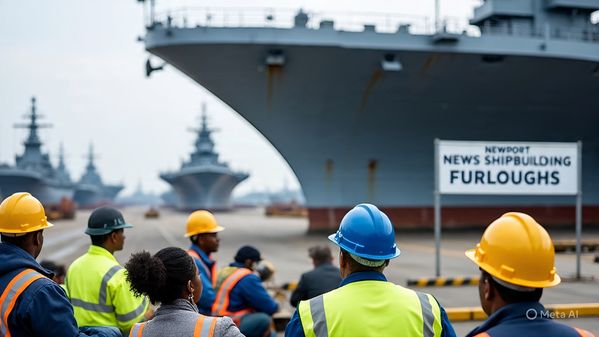Newport News Shipbuilding Furloughs: Navigating the Crossroads of Industry, Workforce, and National Security
The heartbeat of American naval defense—Newport News Shipbuilding—has long been a symbol of resilience, craftsmanship, and strategic importance. Yet, as whispers of furloughs at this iconic Virginia-based shipyard grow louder in 2025, they echo well beyond the shipyard gates. They signal a ripple effect that could touch the national defense supply chain, local economies, and the future of American shipbuilding as we know it.
In this article, we’ll dig deep into the Newport News Shipbuilding furloughs, revealing what’s really happening, why it matters now more than ever, and what it could mean for thousands of workers and the broader U.S. defense infrastructure. We’ll explore firsthand accounts, historical context, policy influences, and practical outcomes—with a level of nuance and human insight no surface-level analysis can provide.
A Turbulent Turn for a Cornerstone of Defense
Newport News Shipbuilding (NNS), a division of Huntington Ingalls Industries (HII), is the sole designer and builder of U.S. Navy aircraft carriers and one of two providers for nuclear-powered submarines. Employing over 25,000 skilled workers, it’s not just a job hub—it’s the bedrock of U.S. naval superiority.
But in early 2025, internal memos and union meetings began to confirm what many feared: furloughs were imminent, affecting hundreds—possibly thousands—of employees. Unlike temporary slowdowns of the past, this time the issue isn’t just supply chain delays or administrative missteps. It’s systemic.
“We were told to prepare for unpaid leave starting in August. It’s hard to wrap your head around it—this is supposed to be a career, not a gig economy job,” said one NNS pipefitter under condition of anonymity.
Let’s unpack what’s really driving these furloughs.
What’s Behind the Newport News Shipbuilding Furloughs?
1. Defense Budget Realignment and Political Gridlock
At the core of the current situation lies a deeper tension between Congress and the Pentagon. The FY2025 defense budget, stalled for months due to partisan negotiations, left multi-billion-dollar shipbuilding contracts in limbo.
-
Aircraft carrier maintenance timelines have been delayed.
-
Submarine procurement funding was scaled back.
-
Payments to NNS for in-progress builds were deferred.
The cascading effect? Project bottlenecks and fewer working hours to allocate to employees.
2. Supply Chain Crunches Are Far From Over
While the COVID-era delays may feel like old news, their residue lingers—especially in industries as specialized as naval shipbuilding. Key components like nuclear propulsion systems, steel forgings, and combat systems electronics are still subject to backlogs from Tier-1 suppliers.
Even a single missing part in the carrier assembly process can stall hundreds of downstream tasks.
“You can’t weld an empty hull or install sonar systems that haven’t arrived,” one foreman explained. “No parts means no progress—and no progress means no paychecks.”
3. Workforce Overcapacity from Past Hiring Spurts
Back in 2021–2023, NNS went on a major hiring spree to meet the projected workload from Columbia-class submarines and Ford-class carriers. But forecasts overestimated readiness and underestimated procurement delays.
Now, the yard finds itself overstaffed relative to active production cycles—a dangerous place for a company tightly tied to federal timelines.
Who’s Being Affected—and How Deep Does It Go?
Contrary to popular belief, the furloughs aren’t blanket layoffs. They’re staggered, rotational, and targeted—for now. NNS leadership is focusing furloughs on:
-
Skilled tradespeople in paused or slow-moving projects.
-
Contracted support workers not directly tied to active defense milestones.
-
Apprentices and trainees whose progress is stymied by lack of onsite work.
According to internal documents reviewed by industry sources:
| Department | Estimated Impact | Furlough Duration |
|---|---|---|
| Welding & Pipefitting | 500–800 workers | 2–4 weeks |
| Electrical Systems | 300–500 workers | 3–6 weeks |
| Program Management | 150–250 staff | Case-by-case |
| Subcontractors | 1,000+ | Indefinite |
More concerning is the economic spillover into the surrounding Hampton Roads region. Local diners, supply shops, and daycare centers that cater to shipyard workers are already reporting declining foot traffic and late payments.
Why This Matters Beyond Virginia
The Newport News Shipbuilding furloughs are not just a local labor story—they represent a strategic vulnerability in America’s ability to project maritime power. Here’s why.
A. National Security Implications
Every week of delay in delivering a Columbia-class submarine or maintaining a Ford-class carrier translates to gaps in deterrence and force readiness—especially amid rising tensions in the South China Sea and Eastern Europe.
B. Loss of Generational Skillsets
Naval shipbuilding is not a plug-and-play industry. Welders, metal fabricators, and nuclear technicians at NNS are trained over years. Furloughs risk attrition. Many may exit the industry permanently for steadier jobs in commercial construction or energy.
“If I have to take weeks off unpaid twice in a year, I might as well hang up my boots and go do HVAC work,” one veteran shipfitter told us. “At least they don’t rely on Congress.”
C. Supply Chain Retraction
Furloughs at the top ripple down. A Pennsylvania-based component manufacturer supplying power distribution modules to NNS recently announced reduced shifts, citing “order pauses” from its shipbuilding client. That’s a silent recession in motion, spreading below the radar.
How Newport News Shipbuilding and Workers Are Responding
HII’s Contingency Measures
Huntington Ingalls has issued cautious public statements, emphasizing that the company is working with federal stakeholders to restore funding pipelines and optimize workflows. Internally, they’ve enacted:
-
Flexible furlough scheduling to minimize income loss.
-
Redeployment programs to shift workers to active project zones.
-
Apprenticeship support to retain early-career talent.
Union Advocacy
The United Steelworkers (USW) Local 8888, which represents thousands at NNS, has ramped up lobbying efforts in D.C., demanding contractual guarantees, backpay protections, and health benefit continuity for furloughed workers.
They’ve also begun filing Freedom of Information Act (FOIA) requests for clarity on government decision-making tied to submarine timelines.
Navigating the Road Ahead: What Comes Next?
The path forward depends heavily on three unpredictable variables:
-
Congressional Budget Resolution: If the FY2025 defense appropriations pass by Q3, paused contracts may resume and furloughs could ease.
-
Supply Chain Normalization: Logistics experts estimate a 6–12 month lag before critical components flow freely again.
-
Retention Strategies: How well NNS retains its core workforce amid uncertainty will determine its long-term resilience.
For now, uncertainty reigns—but resilience is not in short supply at the shipyard.
What Should Workers and Local Stakeholders Do?
For employees, the key is proactive planning and engagement:
-
Stay in touch with your union reps for updates and eligibility options.
-
Review your HR package for temporary unemployment aid and health benefit continuation.
-
Use furlough periods for skill sharpening through NNS’s internal training or local trades programs.
Local businesses should:
-
Coordinate with city chambers to offer bridge programs or discounts to furloughed workers.
-
Adjust staffing and inventory cautiously to avoid overextension.
-
Push for municipal support programs from local officials.
Conclusion: A Test of Grit, Strategy, and Unity
The current wave of Newport News Shipbuilding furloughs isn’t just a budget story—it’s a test of America’s industrial backbone, defense commitment, and worker loyalty. These are not just temporary idle hands. They are the builders of the nation’s most powerful deterrents—the guardians behind steel walls and sonar silence.
And while uncertainty may dock in Hampton Roads for now, history suggests the shipyard will rise again. It always has. Because when it comes to the work of warships and the will of workers, you don’t bet against Newport News.
FAQs: Newport News Shipbuilding Furloughs
Q1: Are the furloughs at Newport News Shipbuilding permanent?
No, as of now, they are temporary and rotational, although duration varies by department. There are no mass layoffs announced.
Q2: Who’s most affected by these furloughs?
Skilled trades like welders, pipefitters, and electricians on paused projects are hit hardest, along with subcontractors and trainees.
Q3: Is the government helping resolve the issue?
Efforts are underway in Congress to finalize the 2025 defense budget, which would release frozen funds tied to shipbuilding contracts.
Q4: Can furloughed workers apply for unemployment?
Yes, in most cases, furloughed employees are eligible for state unemployment assistance, though requirements vary by job classification.
Q5: Will this impact the Navy’s operations?
Delays in ship maintenance or delivery may affect readiness if prolonged, but the Navy has contingency strategies in place for short-term disruptions.
Q6: What are unions doing to support workers?
Unions are actively lobbying, filing FOIA requests, and pushing for guarantees on job security, benefits, and communication transparency.



